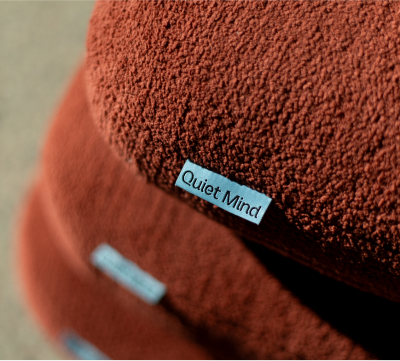Stress is a natural part of being human—but when it lingers, it leaves traces.
You may not even notice it at first. The tension settles quietly in your shoulders. Your breath shortens. Your thoughts race. Over time, this low hum of ongoing stress becomes familiar, even normal. But just because you’ve adapted to it doesn’t mean you’re thriving.
Chronic stress can affect your health, mood, sleep, and sense of connection. It wears on both mind and body, subtly shaping how you move through the world. And yet—your body remembers how to rest. It holds the blueprint for balance.
In this guide, we’ll explore science-backed practices and gentle rituals that can help relieve stress, restore energy, and support your overall wellbeing. You don’t need to be perfect. You just need a place to begin.
Understanding Chronic Stress and Its Impact
Stress is a natural response—one designed to keep you safe in the face of danger. But when it becomes prolonged, driven by constant demands, disconnection, or uncertainty, the effects of chronic stress begin to take a toll on both mind and body.
The body doesn’t distinguish between real danger and a perceived stressor like an overdue email. It responds the same way—activating the fight-or-flight system, releasing adrenaline and cortisol, tightening muscles, and altering body functions like digestion and heart rate. Over time, chronic stress may contribute to illness, including heart disease, immune dysfunction, and more.
|
Physical Effects |
Mental & Emotional Effects |
|
High blood pressure |
Anxiety or panic |
|
Heart palpitations |
Low mood, irritability |
|
Digestive discomfort |
Burnout, disconnection |
|
Sleep disruption |
Trouble concentrating, overthinking |
According to the American Psychological Association, if stress is left unaddressed, ongoing stress may weaken your overall health, lower your health status, and increase the risk of chronic diseases such as cardiovascular conditions and diabetes.
The good news: the body knows how to reset. With the right signals, you can begin managing chronic stress more effectively.
Recognizing the Signs of Chronic Stress
Before you can relieve stress, you must recognize how it shows up. Prolonged stress often hides in plain sight—woven into your posture, your habits, and even your inner voice.
Physical Symptoms
Chronic physical stress may show up as:
- Muscle tightness that lingers
- Digestive changes
- Fatigue that sleep doesn’t fix
- Shallow breath or racing heart
These are not flaws. They’re requests for care—not correction.
Emotional and Cognitive Indicators
The mind shifts too, especially in the presence of stress and anxiety:
- Reactivity instead of reflection
- Heaviness around small decisions
- Diminished joy or curiosity
- Loops of negative thoughts
These symptoms can sometimes be traced to changes in brain regions like the prefrontal cortex and limbic system, which are both impacted by high cortisol and ongoing stress.
Behavioral Changes
During stressful periods, your behavior may shift in subtle ways:
- Avoiding social bonding or connection
- Overusing drugs or alcohol as coping mechanisms
- Losing motivation or interest in daily tasks
- Over-reliance on screens or stimulants like caffeine
Awareness is not a diagnosis. It’s an opening. And the consequences of chronic stress are easier to reverse when caught early.
The Science Behind Stress Recovery
Understanding how your body unwinds from stress makes recovery feel less mysterious—and more possible.
The Role of the Nervous System
The sympathetic nervous system activates your stress response (fight or flight). Its counterpart, the parasympathetic nervous system, guides you back to rest. Chronic stress keeps you stuck in activation.
To reset, your body needs signals of safety—breath, warmth, rhythm. These cues invite your system to soften.
Importance of the Vagus Nerve
The vagus nerve connects brain to body and plays a vital role in recovery. When it’s stimulated, it signals your body to slow down and rest.
You can activate the vagus nerve through:
- Deep diaphragmatic breathing
- Gentle yoga or stretching
- Humming, chanting, or soft vocalization
- Cold exposure (like a cool face rinse)
Strategies to Reset Your Body
There’s no single formula for healing from chronic stress—but your body is always listening, always responding. With gentle, consistent care, you can begin to guide it back to balance.
These strategies are not rules. They’re invitations: to soften, to reconnect, and to remember what safety feels like inside your skin.
Movement: Releasing Stored Stress Through the Body
When stress builds, the body holds it—tight shoulders, clenched jaw, restlessness. Physical activity helps release that tension and signals to your nervous system that it's safe to let go. Some of the best exercises for stress are those that combine movement with rhythm, breath, and sensory grounding.
Consider:
- Walking outdoors: The rhythmic motion combined with fresh air and nature cues can regulate your nervous system and reduce adrenaline.
- Gentle strength training: Builds resilience while re-establishing control and stability.
- Yoga or mobility work: Connects movement with breath, helping to soothe the limbic system and bring awareness back into the body.
The goal here isn’t fitness. It’s presence. Let movement be your way home.
Mindfulness and Meditation: Resetting the Mind-Body Connection
Stress often loops through the mind in the form of negative thoughts, worries, and what-ifs. Mindfulness gently interrupts that loop, helping you return to the present.
|
Practice |
Why It Helps |
|
Breath awareness |
Regulates the nervous system, activates vagus nerve |
|
Meditation |
Reduces cortisol, calms the prefrontal cortex |
|
Mindful movement |
Anchors attention in the body, reducing mental noise |
Start small. Even two quiet minutes can shift your internal rhythm.
Rest and Sleep: Supporting Your Body’s Repair Process
Sleep is not just rest—it’s your body’s nightly repair session. But chronic stress disrupts sleep by increasing adrenaline and cortisol, keeping your body in a heightened state of alertness.
To encourage a good night’s sleep, try:
- Winding down with a calming ritual like tea or soft music
- Keeping a regular bedtime to support your circadian rhythm
- Dimming lights at least an hour before sleep
- Avoiding screens and caffeine in the evening
Sleep isn’t a luxury. It’s a lifeline for your health and wellbeing.
Nourishment and Hydration: Fueling Resilience from Within
When you're under stress, your body burns through nutrients faster. Digestion can slow down. Blood sugar can spike and crash. Over time, prolonged stress affects your gut, hormones, and energy levels—undermining your ability to think clearly, sleep soundly, or emotionally regulate.
That’s why nourishment isn’t just about eating “healthy”—it’s about choosing foods that help your body recover, repair, and regulate.
|
Nutrient |
Sources |
Why It Matters During Stress |
|
Omega-3 fatty acids |
Fatty fish, walnuts, chia seeds |
Reduces inflammation and supports mood stability |
|
Magnesium |
Leafy greens, pumpkin seeds, legumes |
Eases muscle tension, promotes relaxation and deeper sleep |
|
Complex carbohydrates |
Quinoa, oats, sweet potatoes |
Steadies energy and blood sugar, helps regulate the stress response |
When meals are irregular or sugar-heavy, your body becomes more reactive. Choosing slow-digesting, nutrient-rich foods helps calm your nervous system from the inside out.
Hydration is just as vital. Dehydration triggers a mild stress response in the body which leads to raising cortisol and making it harder to think clearly. Keep water nearby. Add a slice of citrus or a pinch of sea salt if needed to make it more inviting.
Relaxation Techniques: Teaching the Body to Feel Safe Again
When stress becomes chronic, the body forgets what relaxation feels like. Muscles stay tense. Breathing becomes shallow. Even in calm environments, the nervous system may stay on alert—expecting something to go wrong.
Gentle, naturally stress-relieving practices can help reintroduce a sense of safety. These techniques send calming signals to both brain and body, gradually shifting you out of the fight-or-flight state and into rest and restoration.
Progressive Muscle Relaxation
This technique helps you distinguish between tension and ease—a crucial step when stress has become your baseline.
- Start at your toes. Inhale gently.
- As you exhale, tense the muscles in that area for a few seconds… then release.
- Move slowly upward: calves, thighs, abdomen, hands, shoulders, jaw.
- With each release, invite softness and breath.
This practice engages both body and brain, creating a felt sense of relief.
Deep Breathing
Breath is the bridge between your conscious mind and autonomic body functions. A simple breath pattern can calm adrenaline spikes, slow heart rate, and lower blood pressure.
Try this 4–4–6 pattern:
- Inhale for 4 seconds
- Hold for 4 seconds
- Exhale for 6 seconds
Repeat for a few cycles. Let your exhale be longer than your inhale—that’s what activates the calming parasympathetic system.
Guided Imagery
Visualization activates the same brain regions involved in real experiences. When you imagine a safe, peaceful place, your body often responds as if you’re there.
- Close your eyes and imagine a setting where you feel safe, calm, and cared for.
- Use all your senses: what does the air smell like? What sounds are nearby? What do you feel under your feet?
- Let yourself linger.
This is more than daydreaming—it’s a way to retrain your nervous system to recognize peace.
Quiet Sensory Support
For some people, adding a gentle sensory cue—like a calming scent or soft pressure—can deepen the feeling of relaxation. Quiet Minds Lavender-scented weighted pillow may help enhance this process by combining light aromatherapy with grounding pressure, offering an added layer of comfort as you practice calming techniques.
Creating a Sustainable Stress-Reduction Plan
Healing from stress isn’t about intensity—it’s about rhythm. Small, repeatable actions create the scaffolding your nervous system needs to feel safe again. Rather than trying to change everything at once, focus on building rituals that feel gentle, supportive, and real for your life.
Setting Realistic Goals
You don’t need to redesign your entire lifestyle. Choose one small shift that feels nourishing—not overwhelming.
Consider:
- A 10-minute walk each morning to signal a fresh start.
- A phone-free hour before bed to help your mind unwind.
- Preparing nourishing meals on Sundays to reduce decision fatigue.
What matters is what feels doable—and repeatable.
Establishing Supportive Daily Rhythms
Routines are not rules—they're anchors. When life feels unpredictable, rhythm creates stability. Repeating certain calming actions each day helps regulate your nervous system and make stress recovery feel less elusive.
Try:
- Morning grounding with breathwork, journaling, or gentle movement.
- A midday pause to stretch, sip water, or step outside.
- Evening transitions like herbal tea, low lighting, or soft music.
- Using a weighted pillow during moments of stillness—whether while reading, resting, or winding down—can provide deep pressure that soothes your body and signals safety to your nervous system.
Routine isn’t restriction—it’s reassurance.
Monitoring Progress with Self-Compassion
You’re not expected to get it right every day. What matters is that you stay in conversation with yourself—listening for what needs care, what needs rest, and what’s quietly working.
You might:
- Keep a soft log of sleep quality, energy, and mood.
- Reflect each week: What helped me feel grounded? What felt draining?
- Adjust gently, with curiosity—not critique.
Healing isn’t linear. Let it be kind.
When to Seek Professional Help
Sometimes, stress asks for more than self-care. It asks for support.
Recognizing the Need for Support
If you feel stuck—overwhelmed, anxious, exhausted—it may be time to reach out.
Watch for:
- Persistent low mood or irritability.
- Struggling with daily tasks.
- Loss of interest in what once brought joy.
- Feeling isolated, even when not alone.
Support is strength, not weakness.
Types of Professional Assistance Available
You don’t have to navigate this alone. Options include:
- Cognitive Behavioral Therapy (CBT): to reframe unhelpful thoughts.
- Mindfulness-Based Stress Reduction (MBSR): to increase awareness and calm.
- Somatic therapy: to process stress held in the body.
- Group therapy or coaching: to find perspective and connection.
Let help in. Let healing begin.
Returning to Calm, One Step at a Time
Resetting from chronic stress isn’t about fixing or forcing—it’s about remembering what soothes you. What steadies your breath. What helps you feel safe in your own body again.
A holistic approach to stress recovery is not a quick solution. It’s a quiet unfolding. It meets you where you are, honors how much you’ve carried, and invites you to soften—bit by bit.
Breathe deeply. Move gently. Rest often. Nourish fully. Connect when you can.
These are not tasks. They are lifelines.
With time, consistency, and care, your nervous system will begin to respond.
It’s not broken. It’s listening. And it’s ready to come home.
About Quiet Mind
At Quiet Mind, we create tools that gently support the body through stress, fatigue, and emotional overwhelm. Our weighted pillows are designed to offer soft, grounding pressure that may help calm the nervous system and invite a sense of safety—especially during moments of rest or recovery.
We know that stress doesn’t always announce itself loudly. Sometimes it shows up as tension you can’t shake, or a tiredness that sleep won’t fix. That’s why everything we offer is rooted in a simple idea: you deserve to feel supported, exactly as you are.
Whether you're building new rhythms, creating space for stillness, or just trying to breathe a little easier, Quiet Mind is here to help you come back to yourself—one calm moment at a time.
Frequently Asked Questions
How long does it take to recover from chronic stress?
Recovery isn’t a countdown. It’s a process. For some it takes weeks, for others it could be months. What matters most is consistency in caring for your body and mind.
What role does nutrition play in stress recovery?
Food is information. A balanced diet stabilizes blood sugar, supports hormone balance, and reduces inflammation—all of which ease stress.
Are certain exercises better for stress relief?
Yes. Walking, yoga, tai chi, and swimming are especially supportive. Choose what feels good, not what feels forced.
How can I lower stress hormones like cortisol?
Move your body. Breathe deeply. Sleep well. Laugh often. Practice stillness. These habits help downregulate the stress response naturally.
Can chronic stress lead to illness?
Over time, yes. It’s linked to heart disease, diabetes, anxiety, and more. That’s why awareness and early action matter.

















